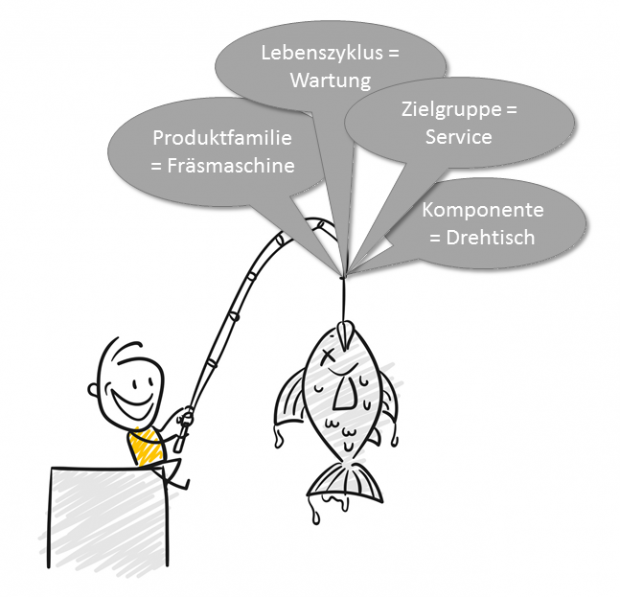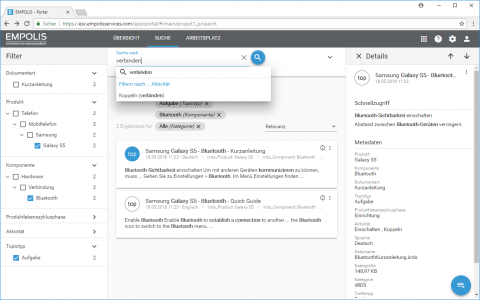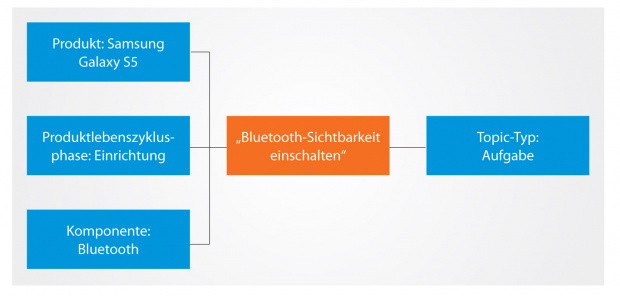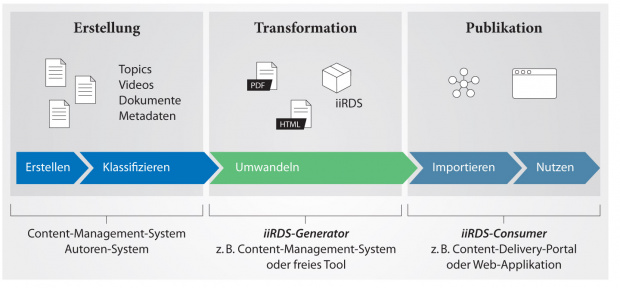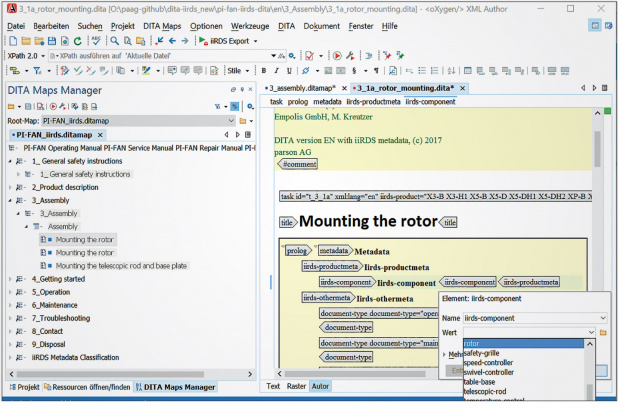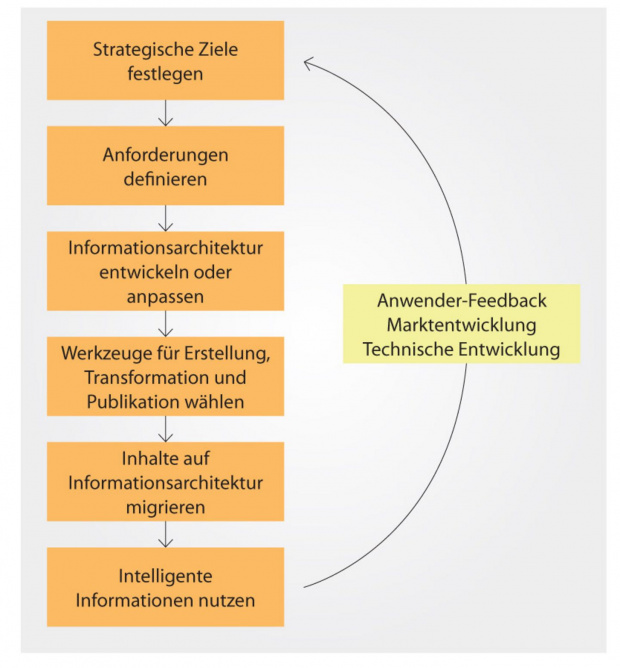Intelligent delivery
Corresponding services: Smart content and iiRDS and Self-service applications
This article was first published in the journal "technische kommunikation", 4/2018.
Version 1.0 of iiRDS was released in April 2018. Now it is important to understand how iiRDS, intelligent information, and content delivery are related. What is intelligent information and how can iiRDS support the delivery of intelligent information?
As digitalization progresses, printed and electronic manuals are replaced by modular and intelligent information that is available online. But can information be intelligent? It cannot when existing on its own. It can become intelligent when it is used in smart applications. For that, intelligent information must have certain properties:
- From the reader's point of view, the information is modular and suitable for various application scenarios, target groups, and contexts.
- From the processing point of view, the information can be integrated from various sources, can be retrieved individually, and dynamically compiled into temporary documents. The information enables interaction with the user.
- From a technical point of view, information is format-neutral, structured, and processable; suitable for various devices and enriched with metadata.
Today, we encounter intelligent information in marketing materials, in wikis, on websites, and in technical documentation. Documents are broken down into many individual components that users and applications can retrieve and process separately.
The Purpose of Content Delivery
In recent years, content delivery has made its way into technical communication. The term content delivery describes the technologies that are used to make content digital and as such available to the user. Wolfgang Ziegler defines "content delivery portals" (CDP) as follows [2]: "CDP provide web-based delivery of modular or aggregated information to different target audiences using content-related search mechanisms.” Simply put, content delivery portals are web shops for information. However, the focus is not on sales but on the efficient delivery of the information that the user needs. Until recently, this information has been delivered mostly in the form of pdf files which users can download from a portal. Now the landscape is changing: Information can be categorized and delivered in smaller chunks thanks to component content management systems and topic-oriented writing. The transition from documents to intelligent information has begun. Users can find the information more easily and no longer have to scroll through long documents [3].
Metadata Is Key
Metadata makes content accessible by describing the target audience and contexts of the content. Machine-readable metadata delivered with the content enables smart applications, such as a content delivery portals, to intelligently select, filter and assemble information. This is how metadata makes our content intelligent.
Digital product information particularly needs the following classes of metadata:
- Identification of the product and the component
- Target audience
- Use case, for example a task or a life cycle phase of the product
- Error scenarios
- Required resources such as time, tools, or operating equipment
Metadata is like bait on a fishing rod - it helps us to catch the right fish from the big information pond. [Source: strichfiguren.de; Fotolia]
Adding Value to Products
Even though manufacturers provide technical documentation for each technical product, they often do not recognize the commercial value of the information that is hidden in the documentation. Customers are not interested in long manuals or heavy ring binders. Rather than extensive documentation, customers expect a good service that helps them.
If you compare the manufacturer's and the user's point of view, you see that they are two sides of the same coin: If manufacturers offer their users intelligent information, both benefit: The manufacturer increases the value of the product and the user needs less time searching for the right information. And time is money. Manufacturers also gain an advantage in the market: As the products of their competitors become more and more similar to theirs, they can strengthen their position by offering better service – with intelligent information.
Publishing intelligent technical documentation on corporate websites or portals, possibly in combination with marketing content, also increases the visibility and reach of corporate content. Technical documentation usually contains the key terms that customers use in internet queries.
Therefore, intelligent information creates new opportunities for companies to stand out from their competitors, improve customer service, and increase visibility. In this way, companies also make technical documentation a higher priority.
There are some common scenarios for intelligent information in content delivery portals:
- Service portals for service employees
- Self-service portals for customers
- Portals for call-center employees
- Guided troubleshooting and diagnosis
In all these scenarios, users are efficiently guided to the information that they need in a particular context.
iiRDS at a Glance
With iiRDS (intelligent information Request and Delivery Standard), tekom aims at defining a non-proprietary standard for the delivery and exchange of intelligent information. A standard is necessary because metadata can only be used across products and manufacturers if it uses the same vocabulary. Even applications can integrate the documentation of different manufacturers only if they can rely on a common exchange format and a manufacturer-independent vocabulary. iiRDS consists of the following:
- A vocabulary for the metadata that is delivered with the content. The vocabulary is limited to the domain of technical documentation; the technical format used is RDF [4].
- A package format for the exchange of intelligent information between applications, for example, content delivery portals, web portals, and component content management systems. ZIP is used as the technical format.
- The specification that explains the structure of the metadata model and package format.
- The iiRDS Consortium is responsible for maintaining the standard. Its members are industrial companies, manufacturers of content management systems, service providers, and associations [5].
Metadata Model Overview
iiRDS metadata can be assigned to text fragments, topics, or documents. The metadata model is based on the PI classification [6] and defines the following types of metadata:
Information type
- Topic type, for example, task, concept, reference
- Document type, for example, service instructions and operating instructions
- Information subject, for example, safety and technical data
Product metadata
- Component
- Product variant
- Product feature
- Product life cycle phase
Functional Metadata
- Events, such as errors
- Planning times, such as maintenance intervals and working time
- Required qualification of the target group
- Tools, spare parts, and consumables
Management metadata
- Identification and status of content, product, and component
- Responsible organization
Navigation metadata for building directory structures
The Package Format
An iiRDS package is technically a ZIP container. It contains the content to be delivered and the associated metadata as RDF. iiRDS defines two variants for the content format:
- Non-restricted packages contain content in any format, such as PDF, HTML, XML, MP4, SVG, or Office files.
- Restricted packages in the so-called iiRDS/A format contain a limited set of file formats and are self-contained. Default formats are PDF/A, a limited media format selection, and XHTML5 with element and attribute restrictions. iiRDS packages are self-contained if the content files only contain references to files within the packages.
The restrictions of the iiRDS/A format ensure that all iiRDS-capable applications can process and display the content in the same or similar ways and with minimum technical effort.
Use of iiRDS in CDP
Content delivery portals can use the iiRDS metadata and the delivered content for various functions, such as search (Fig. 02).
The faceted search (Figure 2, in the screenshot on the left) allows users to quickly narrow down the relevant information (product: "Galaxy S5", component: "Bluetooth").
The semantic search ("Search for") narrows down the information further. The portal suggests suitable concepts for the search (here: "Pair (connect)").
In the example, the entries directly lead to the best hit - the topic "Switch on Bluetooth visibility" in the "Bluetooth Quick Start Guide" (Fig. 03).
Both search mechanisms use the metadata and taxonomies imported via iiRDS.
Content delivery portals also can use knowledge from other sources and link it to the information to create an even better search experience for the user. For example, you can use terminology lists and your own product taxonomies.
iiRDS provides the highway for transporting intelligent information as iiRDS packages. The content delivery portals "stock up" with iiRDS packages to make the information in these packages accessible to their users. Without standardization, CDPs only could read their own packages. Thanks to iiRDS, this works across vendors. But creating intelligent information involves more than content delivery and iiRDS.
Process for Intelligent Information
iiRDS focuses on the delivery format for intelligent information and the vocabulary used to index and find information. However, a business process that creates intelligent information is complex. You need more than a tool that creates iiRDS: You need an authoring or content management system for the content and metadata, an iiRDS generator for generating the iiRDS packages, and an iiRDS consumer for importing, linking and displaying the intelligent information (Fig. 04).
Erstellung intelligenter Information
Der Erstellungsprozess umfasst Inhalte und die Metadaten, mit denen sie klassifiziert werden.
Wie schreibe ich modulare Inhalte? Intelligente Informationen unterscheiden sich auch in ihrer Erstellung von klassischen Dokumenten und Handbüchern: Wenn Informationen aus verschiedenen Quellen und abhängig vom Anwendungsfall nur stückchenweise vom Anwender abgerufen werden, müssen sie anders geschrieben und aufbereitet werden. Als Redakteur wissen Sie nicht, in welchem Zusammenhang der Inhalt auftaucht und wie viel der Leser bereits vorher schon gelesen hat und weiß.
Jedes Stück Inhalt (im Folgenden „Topic“) muss daher in sich abgeschlossen sein. Das bewirken folgende Eigenschaften [7]:
- Das Topic beantwortet genau eine Frage, zum Beispiel „Wie mache ich“, „Was ist …?“ und „Wie funktioniert …?“.
- Das Topic gehört zu einer Informationsart, zum Beispiel anleitend, beschreibend oder definierend.
- Das Topic ist für eine definierte Zielgruppe bestimmt und an deren Lesegewohnheiten und Erwartungen angepasst.
- Die Erklärungstiefe bleibt innerhalb des Topics immer gleich.
Um nun aus unseren getrennten Informationshäppchen wieder ein Gesamtbild zu erzeugen, benötigen Topics eine reichhaltige Verlinkung – sie benötigen Kontext. Dieser wird erzeugt durch Querverweise auf verwandte Themen, Navigationselemente für Topic-Hierarchien oder Dokumentenverzeichnisse und Verschlagwortung auf Grundlage von Metadaten. Der Kontext ermöglicht es den Lesern, den Blick aufs Ganze zu erhalten und sich im großen Meer der Topics zurechtzufinden. Dabei kann auch der klassische Dokumentenkontext hilfreich sein, also die Gruppierung von Topics zu einem Thema und für eine Zielgruppe in einem Dokument.
Erstellungswerkzeuge – iiRDS ist kein Erstellungs-, sondern ein Auslieferungsstandard. Um die technischen Eigenschaften von intelligenten Informationen zu realisieren, muss ein Werkzeug in der Lage sein, strukturierte, modulare Inhalte zu erzeugen, Metadaten zu verwalten und zuzuweisen sowie Inhalte zu verknüpfen. Diese Anforderungen erfüllen die meisten Redaktionssysteme, aber auch XML-basierte Autorenumgebungen wie Oxygen XML Author in Kombination mit dem DITA-Format (Abb. 05).
In solchen Autorenumgebungen werden die Metadaten im Content abgelegt, gemäß dem verwendeten XML-Schema wie DITA oder DocBook. Daher kann es für die Nutzung von iiRDS notwendig sein, das Metadatenschema an die iiRDS-Erfordernisse anzupassen.
Neben dem Erstellen von Inhalt bieten Redaktionssysteme auch Funktionen, um ihn mit Metadaten zu klassifizieren. In der Regel können die Metadaten frei konfiguriert und Taxonomien hinterlegt werden. Viele Redaktionssysteme unterstützen bereits die PI-Klassifikation und sind damit gut auf iiRDS vorbereitet. Die Technischen Redakteure klassifizieren in den Redaktionssystemen die Informationseinheiten wie Topics und Dokumente gemäß dem konfigurierten Metadatenschema in dafür angepassten Masken. Die Metadaten werden getrennt von den Inhalten in Datenbanken gehalten.
Transformation von Inhalten
Die Umwandlung modularer Inhalte und Metadaten in iiRDS-Pakete erfolgt durch so genannte iiRDS-Generatoren, also Werkzeuge für die Generierung von iiRDS-Paketen. Die Transformation umfasst drei wichtige Aufgaben:
- Umwandeln der Inhalte in das gewünschte Zielformat, zum Beispiel HTML oder PDF
- Umwandeln der Metadaten in das iiRDS-konforme RDF-Format
- Paketieren der Metadaten, der Inhaltsdateien, eingebundener Medien, Stylesheets und sonstiger Hilfsdateien in ein iiRDS-konformes Paket
Transformationswerkzeuge können Bestandteil eines Redaktions- oder Autorensystems sein. Mehrere Hersteller von Redaktionssystemen planen, iiRDS in ihren Systemen zu unterstützen.
Aber auch Software-Tools, die unabhängig von Content-Management- oder Autorensystemen arbeiten, können helfen, iiRDS-Pakete aus Inhalten und dazugehörigen Metadaten zu generieren. Dieser Weg bietet sich für standardisierte Formate an. Beispiele dafür sind:
- DITA-Open-Toolkit-Plug-in für die Publikation einer DITA-Map als iiRDS-Paket, zum Beispiel das parson-Empolis Plug-in für DITA [9]
- Publikation eines PDF-Dokuments und separat erfasster Metadaten im Excel-Format als iiRDS-Paket
Publikation und Nutzung
Systeme, die iiRDS-Pakete verarbeiten, werden iiRDS-Consumer genannt. Sie lesen und interpretieren iiRDS-Pakete und bereiten diese für die Nutzung auf. Content-Delivery-Portale mit iiRDS-Import sind also eine Form von iiRDS-Consumern.
Im iiRDS-Standard ist nicht definiert, auf welchem technischen Weg iiRDS-Pakete zwischen einem Generator und einem Consumer ausgetauscht werden. Es gibt also weder ein standardisiertes Protokoll noch eine einheitliche Schnittstelle für diesen Zweck.
In den meisten Fällen wird das am Anfang so aussehen:
- Das erzeugte iiRDS-Paket (eine ZIP-Datei) muss vom Dateisystem des Generators auf ein Verzeichnis kopiert oder verschoben werden, auf das der Consumer Zugriff hat.
- Durch ein Kommando oder einen sich regelmäßig wiederholenden Job wird im Consumer das Einlesen der iiRDS-Datei angestoßen.
- Beim Einlesen des iiRDS-Pakets in ein Content-Delivery-Portal werden die Inhalte und Metadaten abgeglichen, im Portal verfügbar gemacht und für die Suche indexiert.
Umstieg meistern
Die Umstellung der klassischen Erstellungs- und Publikationsprozesse auf intelligente Informationen stellt eine große Herausforderung für die Dokumentationsabteilungen von Unternehmen dar. Und nicht nur für die Technische Dokumentation – intelligente Informationen entstehen abteilungsübergreifend, denn sie aggregieren Informationen aus verschiedenen Quellen, zum Beispiel Schulungsunterlagen, Serviceinformationen, Anwenderberichte und Betriebsanleitungen.
Ein Vorgehensmodell für die Einführung intelligenter Informationen zeigt Abbildung 6.
Wichtig ist, dass das Unternehmen intelligente Informationen als Teil seiner Gesamtstrategie einführt, zum Beispiel als Element der Entwicklung smarter, vernetzter Produkte und Dienstleistungen. Zu den Anforderungen, die mithilfe intelligenter Informationen erfüllt werden sollen, gehören:
- Anforderungen der Kunden, die die digitalen Nutzungsinformationen für die Produkte anwenden: Wie und wo lesen sie die Informationen, wonach suchen sie, welche Werkzeuge verwenden sie? Welche Mehrwerte werden durch die zielgerichtete Auslieferung von Informationen geschaffen, wo bestehen derzeit die größten Schmerzen bei der Nutzung der Produktdokumentation?
- Aus welchen Quellen sollen Informationen in eine intelligente Auslieferung fließen? Neben der Technischen Dokumentation kommen dafür vielleicht auch Schulungsunterlagen, technische Datenblätter, Serviceinformationen oder Marketingmaterial infrage.
- In welchen Systemen und in welchen Formaten werden die Informationen erzeugt, welche Schnittstellen bieten die Systeme? Wie können sie für eine gemeinsame Auslieferung integriert werden?
- Wo entstehen die Informationen und wo werden sie überall verwendet? Was passiert bei Änderungen an der Originalquelle?
Zur Informationsarchitektur gehört neben einer XML-Definition für die strukturierten Inhalte der Technischen Dokumentation
auch ein strukturiertes Format für die Metadaten, mit denen die Inhalte für die Auslieferung angereichert werden. Für die Entwicklung einer nachhaltigen Metadatenstruktur stellt iiRDS eine gute Grundlage dar, da der Standard die wesentlichen Klassen von Metadaten bereits definiert. Sie müssen durch die unternehmensspezifischen Metadatenklassen, zum Beispiel für Produkte, Funktionalitäten und Zielgruppen ergänzt werden. Auch eine bestehende PI-Klassifikation stellt eine sehr gute Basis dar, weil die Metadaten in der Transformation auf die iiRDS-Metadaten abgebildet werden können.
Die Auswahl der Werkzeuge wie Autorenumgebung, iiRDS-Generator und Content-Delivery-Portal basiert auf den definierten Anforderungen und Zielen.
Die Entwicklung intelligenter Informationen ist ein fortlaufender Prozess, der fortwährend an den Erfordernissen der Anwender und des Marktes ausgerichtet werden muss.
Links und Literatur
[1] tekom (2018): iiRDS – The International Standard for Intelligent Information Request and Delivery. www.iirds.org
[2] Ziegler, Wolfgang (2013): Alles muss raus! Content-Delivery für Informationsportale. Band zur tekom-Jahrestagung.
[3] Kreutzer, Martin; Parson, Ulrike (2018): Machen Sie Ihre technische Dokumentation intelligent – der Weg vom Content Management zu Content Delivery.
[4] W3C (Herausgeber): Resource Description Framework (RDF). https://www.w3.org/RDF
[5] tekom (2018): iiRDS Consortium Members: www.iirds.org/iirds-consortium/members/
[6] Ziegler, Wolfgang (2016): Ein Fan von Klasse. In: technische Kommunikation. H. 4, S. 38–45.
[7] Baker, Mark (2013): Every Page Is Page One: Topic-Based Writing for Technical Communication and the Web, XML Press.
[8] PI-Fan: http://i4icm.de/forschungstransfer/pi-klassifikation/der-pi-fan/
[9] Knebel, Marion; Kreutzer, Martin (2017): A Marriage for Life? DITA and iiRDS as a Power Couple for Content Delivery. tekom-Jahrestagung. Folien.

